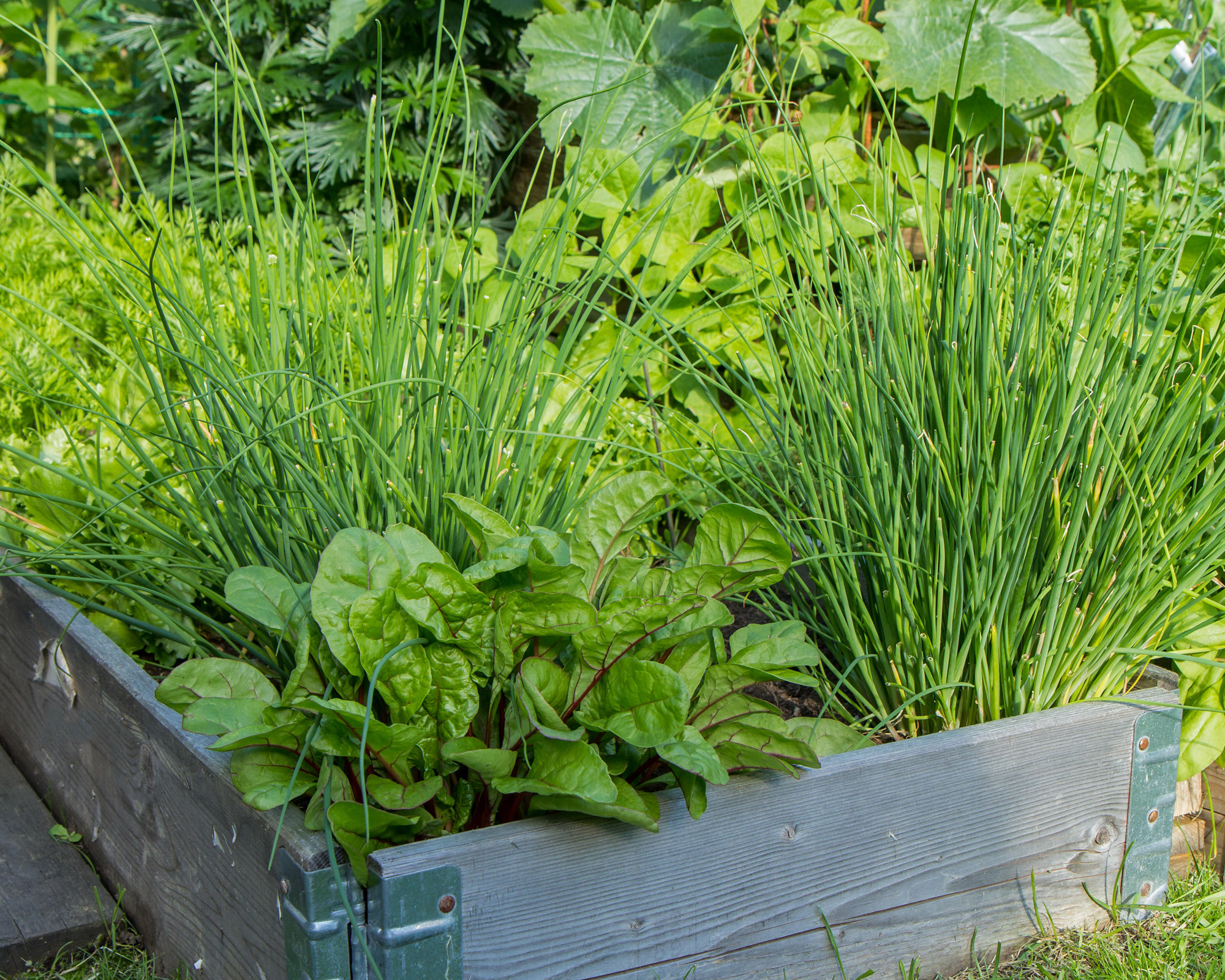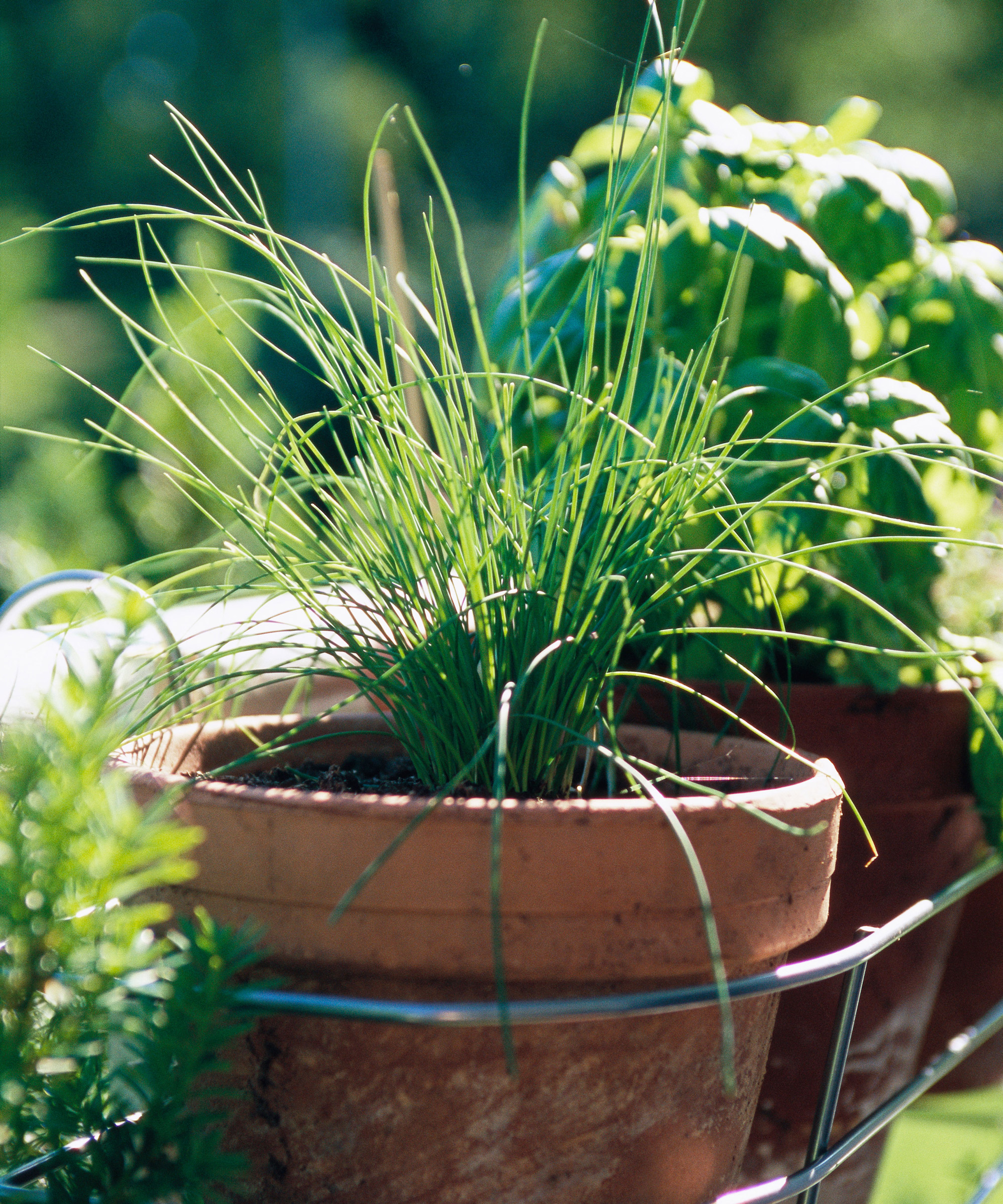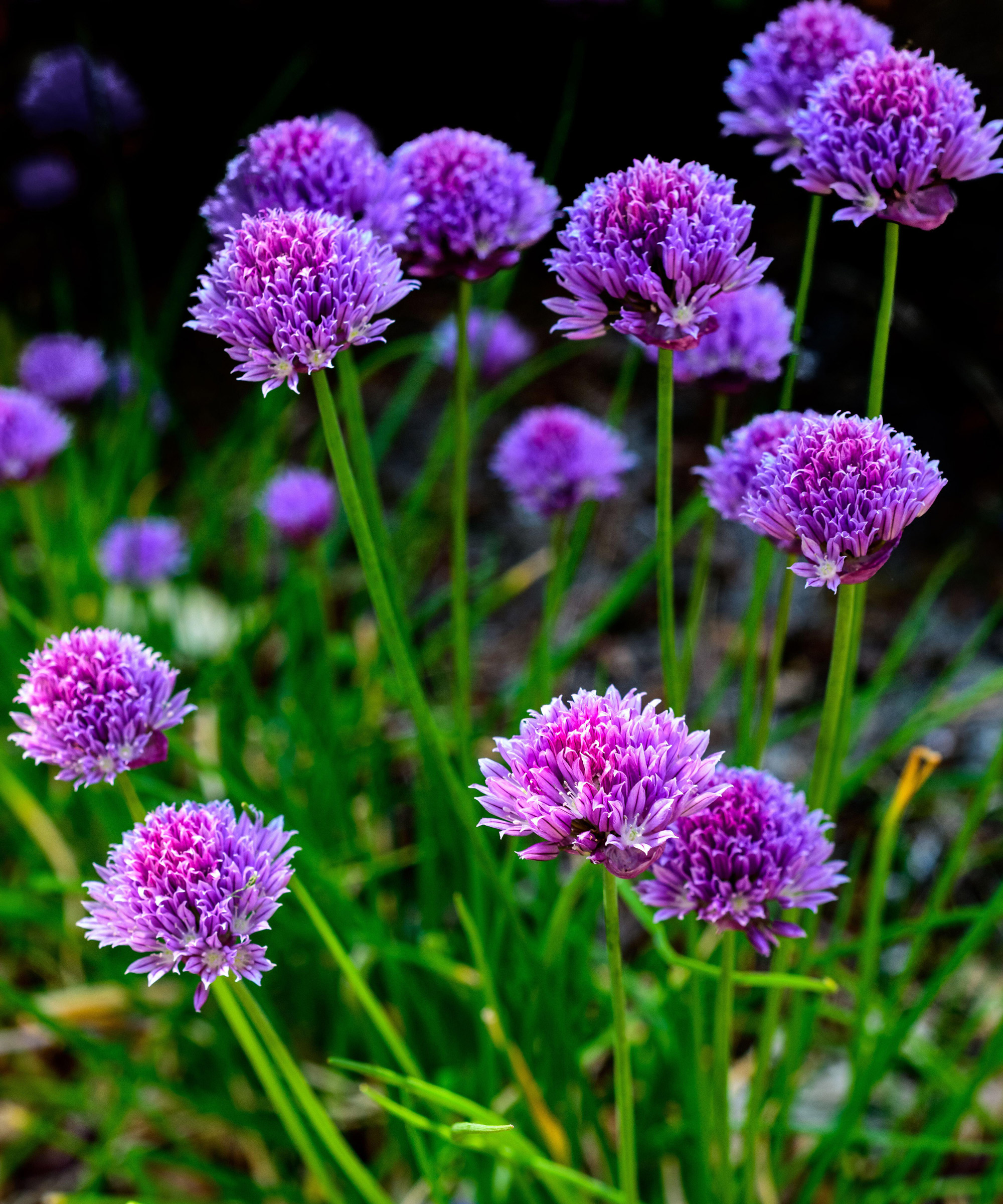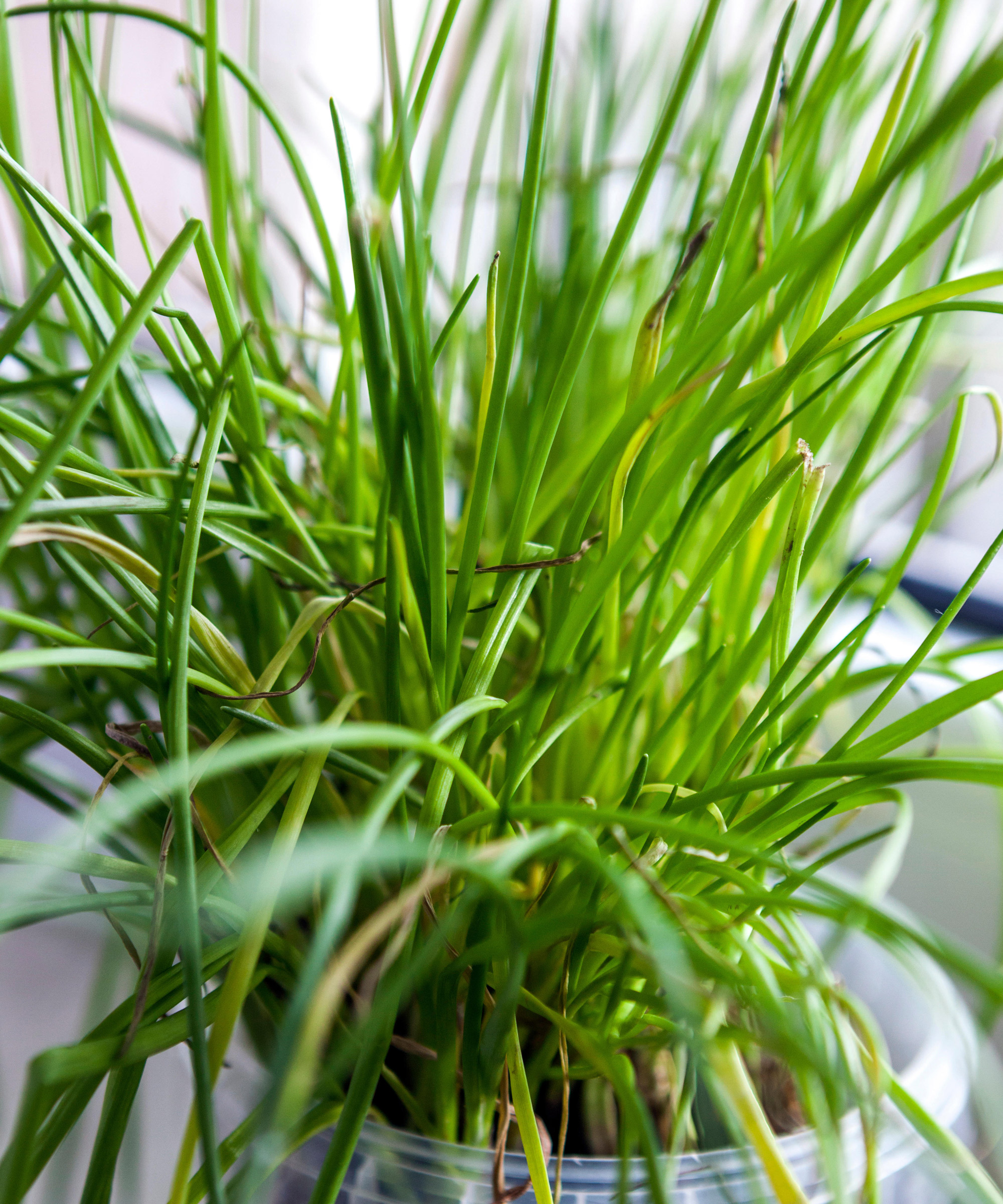Chives care and growing guide: expert tips for this perennial herb
Find out how to grow chives and enjoy months of pretty ornamental blooms, edible herbs and wildlife-friendly alliums


Knowing how to grow chives introduces your garden to some of the prettiest, most charming flowering members of the allium clan. Growing these gentle onion cousins gives you a chance to cultivate versatile edibles that are both easy to grow and highly wildlife friendly. They are also superb companion plants that deter pests from other crops.
These low-maintenance bauble-flowering perennials will add a quaint, natural and easygoing grace to all manner of kitchen garden ideas, big and small, whether you are cultivating a cottage garden, raised beds or a container garden. Their distinctive pompom blooms brighten up the most functional veg beds, while adding a whimsical flourish to mixed flower borders.
The delicate subtlety of the chive makes it a more agreeable culinary choice if you find common garden onions or garlic overpowering. It’s also incredibly long-lasting both as an ornamental and edible plant. Oh, and it has the extra super-power of being a cut-and-come-again classic – literally growing back after cutting, so you get even more mileage out of your crops.
Alongside the common pink and purple chive (Allium schoenoprasum) and varieties such as mild ‘Fine Leaved’ and thick-leaved ‘Staro’, you can grow the taller, flatter-leaved, white-blossomed garlic or Chinese chives (A. tuberosum), and even larger Siberian or blue chives (A. ledebourianum and A. nutans). Whether your preference is plain, heirloom, garlic or giant, there’s a chive to suit your gardening space and culinary needs. Here we show you how to sow, plant, grow and care for yours so you can enjoy months of exquisite edibles.

The distinctive small bauble blooms and pinky purple tones of the chive plant give it a certain cache in the veg garden
Expert tips on how to grow chives
Chives thrive in a range of planting conditions and garden spots. Native to Australia and North America, they flourish in hot regions (zones 3-9), so factor in plenty of sunshine. At least six hours of sun a day is ideal. However, as Chris Bonnett of GardeningExpress.co.uk explains, partial shade is best. 'Overexposure to sun may cause them to droop or dry up,' he says.
While chives have been known to be drought-tolerant, they do better in fertile, well-drained soil that is also moisture-retentive, Chris adds. Chives are resilient but won’t take kindly to root rot, so good drainage is key. If yours is a heavy soil, grow your alliums in raised garden beds to avoid waterlogging. Still, they have broad tolerance of a variety of soil types, flourishing in loamy or sandy textures, with a slightly acidic/neutral pH.
While they prefer warmth, chives are cold-tolerant and adaptable. They like the microclimates afforded by group plantings in mixed borders, beds and cottage gardens. They are an obvious choice for adding ornamental interest to a potager or herb garden, with their pointed foliage and fluffy spherical blooms. And for those who like the idea of having purple flowers in their garden, chives sit well with the likes of lavender, anise hyssop and salvia.

Chives work well with leafy plants like lettuces in wooden crates or brushed metal
When to plant chives
When it comes to how to grow chives, the window of opportunity for sowing is fairly broad and inclusive. For one thing, chives are perennials, which means that there isn’t so much riding on the ‘make or break’ attached with many annual crops – for another, they spring into action in relatively short order.
As a general rule, you can sow direct outdoors from late spring if the ground is warm enough, or slightly earlier if you are prepared to protect your sowings with cloches, cold frames or similar.
However, if you use a greenhouse you can start sowing undercover much sooner (and continue much later). So if you have reached a quiet moment between sowing main crops and waiting for others to harvest, and you’re looking for things to plant in a greenhouse, the good news is you can sow chives as early as late winter and well into summer.
If you wish to plant outside, you should be fine after the risk of last frosts has passed. Early summer is a great time for planting – the longer daylight hours mean plants can hit the ground running and the soil is warmer.
For those who are direct-sowing, the ideal germination temperature is 15-21˚C (60-70˚F). It’s worth making two-three batches of sowings, indoors and outside. Once plants are established, they flower in late spring and early summer, making them amongst the best plants for pollinators like bees and butterflies. Depending on when you sow, they can be harvested any time from early summer to early fall.

Chives flower in May and June, making them a dream planting for attracting butterflies to your garden
How to grow chives from seed
When you learn how to grow chives, you will find they develop fairly quickly with little fuss. However, while they can cope with infrequent or limited attention once established, they appreciate good conditions in the ground (or in the compost!) at the time of sowing and planting. So to encourage the best growth, dig a few inches of well-rotted or aged compost into the ground prior to planting to hold moisture. Knowing how to compost will help with this.
It’s also helpful to add a handful of bone meal for every square metre of the planting site. Do this, and you shouldn’t need to make lots of top-ups later, as you might have to do with other crops – chives are very undemanding later.
- Start seeds at 21˚C (70˚F). Sow thinly in modules, plug trays or small pots of potting compost. Lightly cover with compost or vermiculite. Cover with a clear plastic bag or put in a propagator. Keep moist and warm. As seedlings appear in two-three weeks, remove the bag. At 2in (5cm) high, move to 4in (10cm) pots of multi-purpose, six seedlings per pot. Place somewhere cooler. You can transplant seedlings outside when 4in (10cm) tall, after hardening off.
- For each of your potted ‘clusters’ of seedlings, dig a hole big enough to hold the rootball. If planting multiple chive plants, space each 8-10in (20-25cm) apart. Once planted in your raised bed or border, adjust the plants so the crown is level with the ground. Fill with organic matter or aged compost mixed with soil, then firm in. Scatter a general-purpose granular food around the plants and water well. Water well until established, especially in dry spells.
- If it’s warm enough for direct sowing, grab your best garden rake and gently prepare the ground by raking to a fine tilth. Broadcast-sow seed in rows 8-10in (20-25cm) apart. Sow thinly, quarter of an inch deep, then cover with a thin layer of soil. Once seedlings emerge, thin so plants are 4-6in (10-15cm) apart. If you decide to direct-sow, just bear in mind that your flowering or harvest period may not be extensive as if the chives were sown early indoors

Plant your chives in ‘clumps’ spaced 10in (25cm) apart, ideally in a staggered arrangement
How to grow chives in pots
One thing to bear in mind when you growing chives is that they can spread fairly quickly. If you allow them to flower fully and the seeds to scatter, they can take over in a garden. For that reason, you may prefer to keep your chives in containers – and the good news is you can!
Pots and troughs are also a great idea if you are short on space or restricted in scope. So if you are looking for patio gardening ideas that are practical and decorative, or if you want to add a bit of movement and structure to a sunny wall or doorstep, chives are ideal – especially if grouped with other herbs.
If you are exploring container gardening ideas for chives, many of the same rules apply as for standard planting – just be even more mindful of drainage. Use a moisture-retentive, well-draining compost, and make sure your pot has a few decent drainage holes in the base. Add equal parts grit, multi-purpose and John Innes No3 to your planting mix for better drainage. And as Amateur Gardening’s expert Lucy Chamberlain advises, make sure that the spot you choose has some shade as well as sunshine. Add a liquid feed in spring and summer to supplement growth – and don’t let them dry out.
Choose a fine-leaved variety if you are growing vegetables in pots and group your chives with other quick-growing edibles such as radish, lettuce, dill, chervil, parsley or heartsease pansies for edible flowers. Plants soon produce neat, strong clumps, and regular chopping will stimulate fresh growth.

Chives are ideal container companions for other herbs like basil, as they boost humidity levels to counter the risk of drying out
How to care for chives
Once established, chives are incredibly low maintenance but there are a few things to keep in mind:
- The main thing is to keep the soil or compost moist. Although chives are drought tolerant, make sure that you are watering plants regularly, particularly during dry summer spells, says Chris Bonnett.
- Add a balanced liquid fertilizer in late spring/early summer to stimulate new growth and top-dress with compost. A good mulching with straw, bark or wood chips preserves moisture levels as well as to protect chives from weeds.
- Chives are perennials and it is normal for them to die back naturally over the winter months to burst forth with new growth the following spring. Whilst they are in peak growth, however, you can cut the leaves regularly to promote new growth and maintain a strong bushy plant. Cutting to the ground every six-eight weeks in the growing season will help to rejuvenate your chives.
- Bear in mind that the more chives flower, the less they are inclined to develop new leaves. You might wish to remove flowers if you are growing chives just for eating. But given the decorative nature of chives, you may prefer to keep separate plants for color and for crops. It is wise to keep deadheading flowers to keep seeding in check.
- It's a good idea to repot container-grown chives every few years.

The more chives flower, the less they are inclined to develop leaves, so bear this in mind if you are growing for crops
What to grow with chives
As well as being versatile bee-friendly plants and highly attractive to butterflies, chives are also great to use in conjunction with other plants if you need pest deterrents. For instance, they discourage Japanese beetles, which love flowering fruit trees and roses.
And if you are looking for perfect companion plants for carrots, make sure you plant some chives nearby as they are one of the best ways to deter carrot root flies – and they also enhance the flavor of this root veg when planted close by.
Obviously chives make dynamic planting companions for other herbs like cilantro, parsley and tarragon. However, other great companion planting ideas for your chives include the following crops and ornamentals:
- Plant with celery, lettuce, tomatoes and peas to repel aphids.
- Chives are some of the best companion plants for cucumbers as the powerful oils of the chive help to deter cucumber beetles.
- They are also effective planted near apple trees, as they prevent apple scab and can also keep deer away, which feed on the fruits.
- Grow with strawberries to keep potential feasting animals like pigeons off the scent. Chives also load the ground with nutrients the berries love.
- Partner with any other member of the allium family (garlic, leek, scallion, onion) as they have the same growing requirements.

Chives makes excellent companion plants for the likes of carrots, cabbages and peas, enhancing flavor and deterring pest
Problems growing chives and how to solve them
One of the loveliest things about growing chives is that they are relatively pest- and problem-free. There aren’t really that many things to worry about in comparison with other cropping plants. There are just a few things to watch out for in order to keep your chives in the peak of health.
- Root rot: This can be a problem with tightly packed clumps of chives growing in dense, compact soil with poor drainage. Signs of this are slow growth, mushy stems and distorted or excessively yellow leaves. Anyone focusing on small vegetable garden ideas including chives should just aim to make sure that reasonable space is allowed for these plants to breathe.
- Aphids: Greenfly can be a problem on the young shoots of plants. If you are growing chives in a greenhouse, check for colonies of greenfly on the soft tips and also black sooty moulds caused by the sticky honeydew they secrete. If you want to know how to get rid of aphids, squash pests between thumb and forefinger, or deploy biological controls to restore order.
- Leek rust: Another problem caused by overcrowding, this fungal disease presents as bright yellow spots on the leaves and is more of a risk in long, wet spells. Serious attacks cause leaves to shrivel. If your chives succumb, dispose of plants safely (don’t put them on the compost heap, where the disease will spread). Avoid this problem by making sure clumps are well spaced.

Making sure your chives are well spaced will help prevent the risk of fungal infections like leek rust
When to harvest chives
For anyone who agonizes about optimum windows to harvest vegetables, chives are some of the easiest cropping plants to cultivate. You can harvest from 30 days after planting. As we have said, removing flower buds can help encourage more vigorous leaf growth, but the main thing is to harvest crops often to keep fresh shoots coming.
No special twisting techniques or cutting tools are required: just grab a pair of scissors, wrap your hands around a clump of shoots, and snip a couple of inches above the soil line. Remember to harvest in the morning so leaves aren't dehydrated.
Also, for the refined gourmands, yes: you can also eat the flowers! These are best enjoyed just after the blooms have opened and work best in soups and salads. However, you can’t eat the stems of flowers, so remember to snip, not rip. Harvesting just once a month is advised and can carry on into early fall. While chives are best eaten fresh, they keep well if stored frozen or in butters.

Harvesting chives is easy if you use a nice sharp pair of scissors and cut a couple of inches above the baseline of the stems
Can you grow chives indoors?
Although we encourage you to find room for growing chives in raised beds, pathway edgings, patios and borders, you can just as easily keep them indoors. If you are looking for the best herbs to grow indoors, chives make a lively accompaniment to other herbs you may have nestled on your windowsill.
As with standard planting, make sure the spot you select is sunny but also gifted with partial shade. Ensure ventilation is well maintained to avoid the risk of leek rust and other fungal infections.
If a sunny window is not available, you can also try a grow lamp placed around 10in (25cm) above the pot. Rotate pots regularly to ensure that growth is balanced around the whole plant. Groupings of plants help humidity levels, as does regular misting and pebble trays filled with water. Add a diluted fertilizer twice a month to boost growth.
Indoor growing is recommended for pot-grown chives over winter as they can suffer if exposed to frost and cold winds.

As long as you find a spot with the right mix of sunshine, shade, space and other plants, it’s fine to grow chives inside
How to propagate chives by division
Knowing how to grow chives from seed is just the beginning. Once you have mastered the basics of cultivation, you can get even more out of your chives by learning how to divide the plants every few years.
Herb enthusiasts looking to save money and get free plants will appreciate this. It’s also a key way to keep these herbaceous perennials healthy, prevent congestion, rejuvenate growth and extend plant longevity.
Divide your chives in the winter months (between mid fall and late winter). Lift tired clumps from the garden or remove from pots, and discard the older parts of the plants. Divide into 4in (10cm) diameter sections and replant sections in their own pots of gritty compost. Plant out in spring, or keep indoors. As Lucy Chamberlain points out, division is a quick way to bulk up clump-forming herbs like chives. So there you have it: more chive plants for free!

Being able to divide your chives every few years will enhance the longevity of your herbs and help to keep them healthy
Are there any other flowering alliums I can eat?
Once you know how to grow chives and garlic chives, the chances are you will get hooked on growing flowering edibles with a savory kick, and want to grow more. If you’re wondering whether there are any other flowering alliums you can eat – well, there is something close.
Society garlic (Tulbaghia violacea) isn’t actually in the same allium family as standard garlic. But it has many of the same benefits as chives while delivering a milder pungent hit to its bulbous namesake. It is also far prettier in flower beds – so if you know how to grow garlic and fancy something more decorative, this pretty perennial is for you.
As with standard chives, these borderline hardy South African plants thrive in a sunny, well-drained spot (ideally in zones 7-10). The leaves are a lot like those of chives but a bit more grey, while the flowers (appearing from June onwards) are pinky violet and highly appealing to bees. And for those who are tempted to try, the bulbs are also edible. As well as being edible, this plant is said to keep moles away from other flowers – so well worth having around!

Pretty society garlic is a lovely option if you are keen to grow more flowering edible ‘onion’ type plants
Where to buy chive seeds
When you are learning how to grow chives from seed, you’ll find there are plenty of options. Whether you fancy starting with the common varieties (like ‘Black Isle Bush’), thin-leaved types or fat-leaved A.cepa such as ‘Quattro’, or even one of the garlic chives or Siberian chive varieties, there’s a huge range online. Use our quick links for an easy way to start your chive growing journey.
Where to buy chive seeds in the US:
- Shop chive seeds at Amazon
- Shop chive seeds at Burpee
- Shop chive seeds at Home Depot
- Shop chive seeds at Johnny Seeds
- Shop chive seeds at Walmart
Where to buy chive seeds in the UK:

As assistant editor of Amateur Gardening magazine, Janey's gardening passion was fostered from an early age, when her amazing mum had her deadheading hydrangeas, mulching roses, and propagating strawberry plants from runners for school open days. She's also taken part in lots of conservation and rewilding projects for the RHS and TCV as a way of exploring her horticultural horizons.
